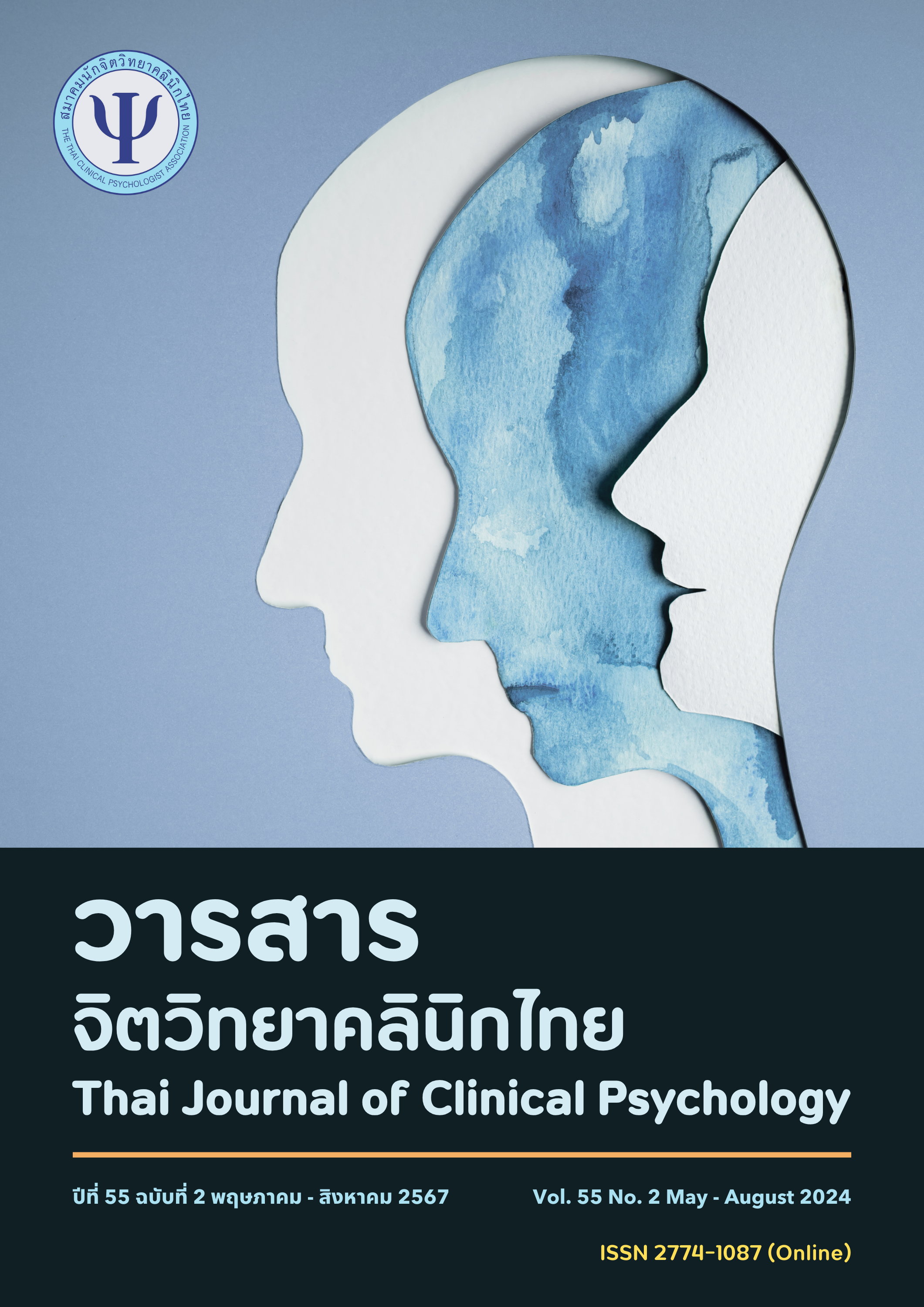คำตอบรอส์ชาคของผู้ป่วยไตวายเรื้อรังที่ต้องการผ่าตัดปลูกถ่ายไต
Main Article Content
บทคัดย่อ
วัตถุประสงค์ เพื่อศึกษาคำตอบรอส์ชาคของผู้ป่วยโรคไตวายเรื้อรังที่ต้องการปลูกถ่ายไต วัสดุและวิธีการ การวิจัยนี้เป็นการวิจัยเชิงพรรณนาภาคตัดขวางโดยเก็บข้อมูลแบบย้อนหลัง (retrospective study) กลุ่มตัวอย่างเป็นผู้ป่วยไตวายเรื้อรังที่ต้องการผ่าตัดปลูกถ่ายไตและมารับบริการการตรวจทางจิตวิทยาที่คลินิกจิตเวชโรงพยาบาลราชวิถีตั้งแต่เดือนตุลาคม พ.ศ. 2561 ถึงเดือนเมษายน พ.ศ. 2566 ตามเกณฑ์ที่กำหนดจำนวนทั้งสิ้น 115 ราย ทำการเก็บข้อมูลด้วยแบบสอบถามทั่วไปและแบบทดสอบรอส์ชาค วิเคราะห์ข้อมูลโดยใช้สถิติดังนี้ ความถี่ ร้อยละ ค่าเฉลี่ยและส่วนเบี่ยงเบนมาตรฐาน ผลการวิจัย พบว่า กลุ่มตัวอย่างส่วนใหญ่เป็นเพศชาย อายุเฉลี่ย 44 ปี สถานภาพสมรส จบการศึกษาระดับมัธยมศึกษา ยังคงทำงานและใช้สิทธิการรักษาประกันสังคม โดยพบลักษณะคำตอบรอส์ชาค ด้านตำแหน่งเนื้อที่ของภาพ (location) ส่วนใหญ่ให้คำตอบ W ร้อยละ 61.44 ด้านเหตุผลของคำตอบ (determinant) ส่วนใหญ่ให้คำตอบ F ร้อยละ 60.2 ด้านเนื้อหาหรือชนิดของคำตอบ (content) ส่วนใหญ่ให้คำตอบ A ร้อยละ 50.3 จำนวนคำตอบทั้งหมด (total response) มีค่าเฉลี่ย 16.4 คำตอบที่คนส่วนใหญ่มักจะตอบ (popular response) มีค่าเฉลี่ย 4.5 สรุป กลุ่มตัวอย่างให้คำตอบ W และ คำตอบ A ทั้งคู่สูงกว่าเกณฑ์ปกติ ส่วนจำนวนคำตอบทั้งหมดและคำตอบที่คนส่วนใหญ่มักจะตอบ ให้ต่ำกว่าเกณฑ์ปกติทั้งคู่ แสดงให้เห็นว่าผู้ป่วยไตวายเรื้อรังน่าจะมีความสามารถจำกัดหรือมีปัญหาทางจิตใจ อารมณ์ จึงควรมีการตรวจประเมินหรือคัดกรองเพิ่มเติม หากพบปัญหาดังกล่าวควรส่งต่อ พบผู้เชี่ยวชาญเฉพาะทางเพื่อร่วมดูแลรักษา
Article Details

อนุญาตภายใต้เงื่อนไข Creative Commons Attribution-NonCommercial-NoDerivatives 4.0 International License.
เรื่องที่ลงตีพิมพ์ในวารสารจิตวิทยาคลินิกแล้วถือเป็นลิขสิทธิ์การเผยแพร่โดยวารสารจิตวิทยาคลินิกแต่เพียงผู้เดียว การตีพิมพ์หรือเผยแพร่ซ้ำในที่อื่นต้องได้รับอนุญาตจากกองบรรณาธิการวารสารฯ
เอกสารอ้างอิง
Chawarit, P. (2015). Characteristic of the Rorschach responses of inmates incarcerated for amphetamine offences [Unpublished master’s thesis]. Ramkhamhaeng University.
Khlaisuk, A. (2019). Mental illness in chronic disease patient: Role of psychiatric community nurses. Journal of Nursing Science Chulalongkorn University, (30)3, 11-18. (in Thai)
Lortajakul, C., Ratanaprariyanuch, S. and Sanamjang, P. (2018). Depression, social support, and quality of life of the end stage chronic kidney disease patients with hemodialysis. Journal of Nursing Science Chulalongkorn University, (30)3, 141-152. (in Thai)
Phetrat, S. (2010). Rorschach responses of substance dependent youths: A case study of the Songkhla drug dependence treatment center. [Unpublished master’s thesis]. Ramkhamhaeng University.
Phongphisutchai, S. (2004). The study of Rorschach responses in forensic psychiatric patients: Homicide. [Unpublished master’s thesis]. Mahidol University.
Plookrak, S. (2018). The prevalence and associated factors of depression in ESRD on hemodialysis in Phra Nakhon Si Ayutthaya hospital. Journal of Preventive Medicine Association of Thailand, (8)1, 72-80. (in Thai)
Sattayaprasert, K. (2013). A comparative study of Rorschach responses between depressive patients with a history of attempted suicide and Those without a history of attempted suicide: A case study of Rajavithi hospital. [Unpublished master’s thesis]. Ramkhamhaeng University.
Srigratoom, B. (2015). Rorschach responses of bipolar patients [Unpublished master’s thesis]. Ramkhamhaeng University.
Suwanaleart, S., Pornpipatkul, S., & Wanichrammanee, K. (2012). Scoring manual of Rorschach test (5th ed). Beyond Publishing. (in Thai)
Wichitsunthornkul, K. (2022). Epidemiology and review of preventive measures for chronic kidney disease. (n.p.). https://ddc.moph.go.th (in Thai)


